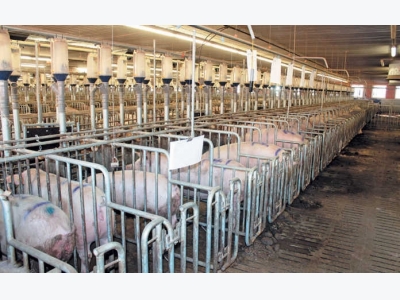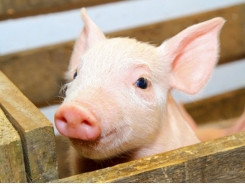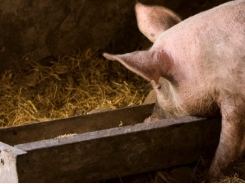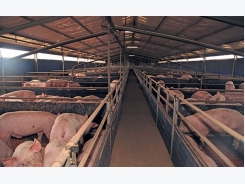Investing in animal welfare pays off for German piggery

With the welfare of farm animals under close scrutiny in Europe, farmers there are increasingly utilising technologies and systems that balance animals’ well-being with profitability. Lloyd Phillips recently toured a modern sow unit near Magdeburg in Germany to witness this approach first-hand.
Sows that have been artificially inseminated spend a few days in these wider-than-average pens to enhance fertilisation. Photo: Lloyd Phillips
On a visit to a modern, trendsetting 2 400-sow unit near Magdeburg in the German state of Saxony-Anhalt, it is immediately evident that any pathogens wanting to get into this piggery will have a hard time trying.
Only with prior approval are my guide and I allowed through the perimeter fence.
From here, we head straight into the reception building, where the piggery manager – from behind a hermetically sealed plate glass window – instructs us to place our electronic gadgets, notebooks and pens into a high-tech box that decontaminates them using ultraviolet light.

Steffen Martens of Big Dutchman pig equipment, shows off the plastic slatted floors that enable urine and dung to fall through into a slurry trough below.
He accesses our now-sterile items from his ‘clean’ side of the window and sends us on to the next stage. My guide and I undress, leaving our non-sterile personal clothing in a room, before proceeding to a shower to decontaminate our bodies.
Stark naked, we emerge through the shower’s opposite door into another room where we get dressed into clean and decontaminated overalls and boots. Only now are we allowed into the piggery. The process will be repeated, but in reverse, when we leave.
Background
Eight German pork producers established the sow unit near Magdeburg a few years ago to ensure a consistent supply of top-quality, three-week-old, weaned piglets, produced under the best animal welfare conditions, for their businesses.
This is according to a representative of the shareholders, who spoke to Farmer’s Weekly on condition of anonymity.
Construction of this greenfield facility began in 2014, and by early 2015 the first gilts were moved into their housing. The sow unit is now fully operational and produces piglets for fattening and finishing- off at 120kg liveweight.
“The design used for this sow unit is so new and revolutionary that it has been used only five times so far in the whole of Europe,” the representative says.
Approximately 120 sows farrow every week, producing an average of 13,1 weaned piglets per litter. Each week, on a rotational basis, one of the eight shareholder farmers takes a batch of about 1 570 piglets from the sow unit to his or her fattening and finishing farm.
The furthest shareholder’s farm is about 300km from Magdeburg.
“Our sows average 2,35 breeding cycles a year to each produce a total of about 30 weaned piglets per year. The average conception rate among the sows is 91%, which is a profitable production figure,” he explains.
The sow unit, with its highly sophisticated systems, was by no means cheap. The cost came to about €2 500/sow (about R36 000/ sow) or a total of €6 million (R86 million) for the 2 400 sows.

Many of the sow unit’s production processes are computerised, making it one of the most modern piggeries in Europe.
State-of-the-art technology
To achieve positive returns on the investment, it is essential to understand and utilise the housing technology to its full potential, and combine this with top pig genetics, feed, biosecurity, veterinary care and breeding management.
This results in maximum production of marketable piglets, and the greatest profitability for the sow unit, the representative explains.
Big Dutchman International equipment is used, and Steffen Martens, a pig equipment sales consultant with the company, has been closely involved with the development and operations at the facility.
“This is the best sow unit design that there is in Germany, and even Europe, for achieving the balance between animal welfare and profitability,” he says.
To ensure optimal animal welfare, equipment ranging from computer software programs, operating quietly behind the scenes, to the more obvious group housing equipment, have been specially developed by Big Dutchman International.
“Keeping pigs happy is essential for their welfare because stress will affect their performance and health,” the company says in a statement. “Modern pig production must, therefore, be economically viable but also needs to take into account consumer demand for animal-friendly systems.”
Modern production system
The artificial insemination unit is the starting point of sow production in any modern piggery. This housing needs plenty of light, with as much daylight as possible via hermetically sealed windows and skylights.
According to Martens, the housing for both inseminated and dry sows has been designed to minimise potential aggression among sows.
This design also ensures that individual sows can receive their full feed allocation without being harassed by other sows in the group pen, while still having ample freedom of movement.
Group housing has a number of advantages, including allowing a sow’s musculoskeletal system to recover better and faster after farrowing. The sows can also establish a natural hierarchy early on.
In addition, sows kept in groups get back on heat faster and more easily, and they can be stimulated more intensively by teaser boars run in corridors adjacent to sow group pens.
An insemination door integrated into a group housing stall allows for easy handling of sows that are due for artificial insemination.
Gestating sows housed in group pens have access to multiple feeding troughs separated from each other by shoulder boards. These troughs allow all the sows to consume either liquid or dry feed at the same time without being harassed by more dominant sows.
This ensures that each gestating sow receives all the required nutrition.
The Big Dutchman electronic sow feeding (ESF) Call-Inn system has also been installed at the facility.
“Every animal is identified via a unique electronic ear-tag that the automated feeding system uses to determine and supply the precise feed that a particular sow needs according to her body condition,” Martens explains.
“Only one sow can enter the feeding station at a time and she is able to feed until finished before the exit door opens to let her out. Then the entrance door opens to let the next sow in to feed.”
An added advantage of the system is that it has an optional heat detection feature that can colour-mark sows in heat, for easy visual identification.
Up to 64 sows can be fed by a single Call-Inn system.
Adjustable farrowing crates
One of the most controversial aspects of intensive pig production worldwide remains the often-cramped farrowing crates used to keep sows from accidentally squashing and injuring or killing their piglets.
To enhance the welfare of sows that are suckling piglets, free movement pens have been installed for each sow.
“The farrowing frame can be fixed in the open position prior to farrowing,” explains Martens.
“Before farrowing, the sow is given access to nest-building materials, such as straw, to allow her to act according to her natural instincts.
Just before she’s due to farrow, the sow unit staff can adjust the farrowing frame to a smaller, but still comfortable, position to allow the piglets a few days to find their feet and their way around without being injured by their mother.”
Once the piglets are mobile enough to avoid being trampled by their sow, the farrowing frame can be extended again to allow the sow free movement for the remainder of the suckling period.
The farrowing system also has a durable plastic slatted floor that allows dung and urine to fall through to a slurry system beneath.
A further advantage is that heating plates can be installed in the floor to create a warm microclimate for the piglets.
Once weaned, and before they are shipped off to shareholders’ farms for finishing, the piglets spend some time in the piglet-rearing section.
The pens here are equipped with animal-friendly, anti-slip plastic flooring that is also slatted to enable dung and urine to fall through, thereby preventing unhygienic conditions.
The plastic walls of the pens also allow for easy cleaning and minimise the risk of injury.
Keeping the pigs stimulated
To prevent boredom among the pigs, a variety of toys have been provided to keep them stimulated. One is a foraging tower filled with straw that the pigs can pull out and play with.

All of the pigs at the Magdeburg sow unit are given access to toys to play with to keep them from potentially becoming bored.
The pigs also enjoy playing with a system of chains attached to chew toys on one end and a swing system on the other. In addition, there is a chew stick dispenser, a sisal rope dispenser, a scratching post with playing chain, and a hay rack, all of which the pigs can safely chew on.
Balancing fresh air circulation with indoor heating, especially during Germany’s cold winters, in the closed environment is essential for optimal pig welfare.
Keeping the facility too closed-up could result in toxic ammonia levels, while excessive airflow would allow warm air to escape and risk the pigs becoming chilled.
A computerised and automated climate control system can detect any build-up of potentially dangerous gases and monitors interior temperatures. A system of motorised fresh air inlets and vents maintains air and temperature quality at levels well within European Union animal welfare parameters.
Future plans
According to the shareholders’ representative, the projected operational lifespan of the Magdeburg sow unit is approximately 20 years.
“We’re not planning any expansion of the facility. However, after about 15 years, we’ll evaluate whether the operation will continue.
If yes, we’ll look at what needs to be modified or replaced to ensure that animal welfare, productivity and profitability are maintained at the highest levels of that time. However, if new animal welfare legislation is introduced in the interim we’ll adapt the sow unit to effectively meet these legislative requirements,” he says.
Related news
Tools

Phối trộn thức ăn chăn nuôi

Pha dung dịch thủy canh

Định mức cho tôm ăn

Phối trộn phân bón NPK

Xác định tỷ lệ tôm sống

Chuyển đổi đơn vị phân bón

Xác định công suất sục khí

Chuyển đổi đơn vị tôm

Tính diện tích nhà kính

Tính thể tích ao









 Basic requirements for the sleeping…
Basic requirements for the sleeping…  How whey can cut the…
How whey can cut the…